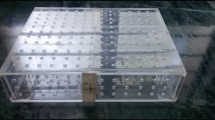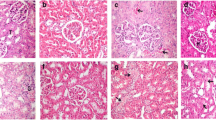Abstract
This study was focused to evaluate protection of indigenous antioxidant system of mice against gamma radiation-induced oxidative stress using a semiquinone (SQGD)-rich fraction isolated from Bacillus sp. INM-1. Male C57bl/6 mice were administered SQGD (50 mg/kgb.w.i.p.) 2 h before irradiation (10 Gy) and modulation in antioxidant enzymes activities was estimated at different time intervals and compared with irradiated mice which were not pretreated by SQGD. Compared to untreated controls, SQGD pretreatment significantly (p < 0.05) accelerates superoxide dismutase, catalase, GSH, and glutathione-S-transferase activities. Similarly, significant (p < 0.05) increase in the expression of superoxide dismutase, catalase, GSH, and glutathione-S-transferase was observed in irradiated mice pretreated by SQGD, compared to only irradiated groups. Total antioxidant status equivalent to trolox was estimated in renal tissue of the mice after SQGD administration. Significant ABTS+ radical formation was observed in H2O2-treated kidney homogenate, due to oxidative stress in the tissue. However, significant decrease in the levels of ABTS+ radical was observed in kidney homogenate of the mice pretreated with SQGD. Therefore, it can be concluded that SQGD neutralizes oxidative stress by induction of antioxidant enzymes activities and thus improved total antioxidant status in cellular system and hence contributes to radioprotection.





Similar content being viewed by others
References
Ozbek E (2012) Induction of oxidative stress in kidney. Int J Nephrol 2012:1–9
Breitz H (2004) Clinical aspects of radiation nephrology. Cancer Biother Radiopharm 19:359–362
Krochak R (1986) Clinical manifestation and pathophysiological mechanism. Urology 27:389
Simic MG, Taylor KA, Ward JF, yon Sonntag C (1988) Oxygen radicals in biology and medicine. Plenum, New York
Saha A (1995) Radiation-induced inactivation of enzymes-a review. Radiat Phys Chem 46:123–145
Hamid AA, Aiyelaagbe OO (2010) Antioxidants: its medicinal and pharmacological applications. Afr J Pure Appl Chem 4:142–151
Kumar R, Bansal DD, Patel DD, Mishra S, Karamalakova Y, Zheleva A, Gadjeva V et al (2011) Antioxidative and radioprotective activities of semiquinone glucoside derivative (SQGD) isolated from Bacillus sp. INM-1. Mol Cell Biochem 349:57–67
Kumar R, Sharma RK, Bansal DD, Patel DD, Mishra S, Miteva L, Gadjeva V, Dobreva Z, Stanilova S (2011) Induction of immunostimulatory cytokine genes expression in human PBMCs by a novel semiquinoneglucoside derivative (SQGD) isolated from a Bacillus sp. INM-1. Cell Immunol 267:67–75
Patel DD, Bansal DD, Bansal DD, Mishra S, Arora R, Sharma RK, Jain SK, Kumar R (2012) A semiquinone glucoside derivative (SQGD) provides protection to male reproductive system of the mice against gamma radiation toxicity. Environ Toxicol. doi:10.1002/tox.21781
Patel DD, Bansal DD, Mishra S, Arora R, Sharma A, Sharma A, Jain SK, Kumar R (2012) Radioprotection to small intestine of the mice against ionizing radiation by semiquinoneglucoside derivative (SQGD) isolated from Bacillus sp. INM-1. Mol Cell Biochem 370(1-2):115–125. doi:10.1007/s11010-012-1403-y
Kruger NJ (1996) The Bradford method for protein quantification. The Protein Protocols Handbook. Humana, Totowa, pp 15–20
Marklund S, Marklund G (1974) Involvement of the superoxide anion radical in the autoxidation of pyrogallol and a convenient assay for superoxide dismutase. Eur J Biochem 47:469–474
Aebi H (1984) Catalase in vitro. Methods Enzymol 105:121–126
Habig WH, Pabst MJ, Jakoby WB (1974) Glutathione S-transferases: the first enzymatic step in mercapturic acid formation. J Biol Chem 249:7130–7139
Beutler E, Duron O, Kelly BM (1963) Improved method for the determination of blood glutathione. J Lab Clin Med 61:882–888
Connor PM, Evans RG (2010) Structural antioxidant defense mechanism in mammalian and nonmammalian kidney: different solutions to the same problem? Am J Physiol Regul Integr Comp Physiol 299:R273–R277. doi:10.1152/ajpregu.00364.2010
Karbownik M, Reiter RJ (2000) Antioxidative effects of melatonin in protection against cellular damage caused by ionising radiation. Proc Soc Exp Biol Med 225:9–22
Zingman S, Reddan J, Schultz JB, McDaniel T (1996) Structural and functional changes in catalase induced by near-UV radiation. Photochem Photobiol 63:818–824
Meister A, Anderson ME (1983) Glutathione. Annu Rev Biochem 52:711–760
Meister A (1994) Glutathione, ascorbate and cellular protection. Cancer Res 54:1969–1975
Bump EA, Brown JM (1990) Role of glutathione in radiation response of mammalian cells in vitro and in vivo. Pharmacol Ther 47:117–136
Bhatia AL, Manda K (2004) Study on pretreatment of melatonin against radiation induced oxidative stress in mice. Environ Toxicol Pharmacol 18:13–20
Navarro J, Obrador E, Pellicer JA, Aseni M, Vina J, Estrela M (1997) Blood glutathione as an index of radiation induced oxidative stress in mice and human. Free Radic Biol Med 22:1203–1207
Lewin S (1976) Vitamin C: its molecular biology and medical potential. Academic Press, New York 42
Nakamura Y, Ohigashi H, Masuda S, Murakami A, Morimitsu Y, Kuwamoto Y, Osawa T, Imagawa M, Uchida K (2000) Redox regulation of glutathione-s-transferase induction by benzyl isothiocyanate: correlation of enzyme induction with the formation of reactive oxygen intermediates. Cancer Res 60:219–225
Reddy AM, Kumar SG, Jyothsnakumari G, Thimmanaik S, Sudhakar C (2005) Lead induced changes in antioxidant metabolism of horsegram (Macrotyloma unifloram (Lam.) verdc.) and Bengal gram (Cicer arietinum L.). Chemosphere 60:97–104
Acknowledgments
Authors would like to acknowledge Defence Research and Development Organisation for financial assistance for the project (1.3 of ST-P1, INM-311) as well as for awarding Senior Research Fellowship. Authors would also like to acknowledge Mrs. Ritu Tyagi (Senior Research Fellow, DRDO) and Mr. A. R. Khan (Senior Research Fellow, DRDO) from NMR Research Centre, INMAS, for their assistance in designing and conducting the experiments.
Conflict of interest
The authors declared no conflict of interest.
Author information
Authors and Affiliations
Corresponding author
Rights and permissions
About this article
Cite this article
Mishra, S., Reddy, D.S.K., Jamwal, V.S. et al. Semiquinone derivative isolated from Bacillus sp. INM-1 protects cellular antioxidant enzymes from γ-radiation-induced renal toxicity. Mol Cell Biochem 379, 19–27 (2013). https://doi.org/10.1007/s11010-013-1622-x
Received:
Accepted:
Published:
Issue Date:
DOI: https://doi.org/10.1007/s11010-013-1622-x




